Maybe you haven’t heard of the CloudFront web site. But when you browse the Net, lots of pop-up advertisements from CloudFront are shown. And these undesired pop ups can appear again and again, even you close them. It could mean that an unwanted software from the adware (also known as ‘ad supported’ software) family get installed on your personal computer. The ‘ad supported’ software can change system setting in order to start automatically when the machine launch. You will be annoyed about it. Such as other undesired software, the adware can show advertisements without your’s permission, and these unwanted ads is difficult to shut down. The worst is, the CloudFront web-site be able to gather a wide variety of your personal information.
It’s not a good idea to have an undesired program like the ad-supported software that reroutes your web browser to the CloudFront web site. The reason for this is simple, it doing things you do not know about. The worst is, the ad supported software has the ability to collect a wide variety of confidential info that may be later used for marketing purposes. You don’t know if your home address, account names and passwords are safe. And of course you completely do not know what will happen when you click on any CloudFront pop-up advertisements.
The adware can alter the settings of the Microsoft Internet Explorer, Google Chrome, Mozilla Firefox and Microsoft Edge, but often that a malicious software like this can also affect all types of internet browsers by changing their desktop shortcuts. Thus forcing the user each time start the web-browser to see an unwanted CloudFront page.
So, if you happen to encounter undesired CloudFront pop-up ads, then be quick and take effort to remove adware from your computer as soon as possible. Follow the step by step guide below to remove CloudFront redirect virus. Let us know how you managed by sending us your comments please.
How to remove CloudFront redirect virus
The following guidance will allow you to remove CloudFront redirect from the Mozilla Firefox, Google Chrome, Internet Explorer and MS Edge. Moreover, the step-by-step tutorial below will allow you to get rid of malware, hijacker infections, potentially unwanted software and toolbars that your machine may be infected. Please do the instructions step by step. If you need help or have any questions, then ask for our assistance or type a comment below. Read it once, after doing so, please print this page as you may need to shut down your web-browser or restart your PC.
To remove CloudFront redirect, perform the steps below:
- How to manually remove CloudFront redirect
- Uninstall suspicious software by using Windows Control Panel
- Remove unwanted Scheduled Tasks
- Fix hijacked web-browsers shortcuts to remove CloudFront redirect
- Delete CloudFront redirect from Mozilla Firefox by resetting web browser settings
- Remove CloudFront pop up advertisements from IE
- Remove CloudFront redirect from Chrome
- How to automatically delete CloudFront redirect virus
- Block CloudFront redirect and other annoying web-pages
- How can you prevent your computer from the attack of CloudFront redirect virus
- Finish words
How to manually remove CloudFront
Most common adware may be uninstalled without any antivirus applications. The manual ad supported software removal is step-by-step guide that will teach you how to get rid of the CloudFront redirect.
Uninstall suspicious software by using Windows Control Panel
We suggest that you begin the machine cleaning procedure by checking the list of installed programs and delete all unknown or questionable software. This is a very important step, as mentioned above, very often the harmful software such as adware and hijackers may be bundled with free software. Uninstall the unwanted applications can get rid of the intrusive ads or internet browser redirect.
Windows 10, 8.1, 8
Click the Microsoft Windows logo, and then click Search ![]() . Type ‘Control panel’and press Enter as shown on the image below.
. Type ‘Control panel’and press Enter as shown on the image below.

Once the ‘Control Panel’ opens, click the ‘Uninstall a program’ link under Programs category as shown in the following example.

Windows 7, Vista, XP
Open Start menu and choose the ‘Control Panel’ at right as displayed in the figure below.

Then go to ‘Add/Remove Programs’ or ‘Uninstall a program’ (Microsoft Windows 7 or Vista) like below.

Carefully browse through the list of installed programs and remove all suspicious and unknown applications. We advise to click ‘Installed programs’ and even sorts all installed programs by date. After you have found anything suspicious that may be the adware that responsible for the appearance of CloudFront popups, then choose this program and press ‘Uninstall’ in the upper part of the window. If the suspicious application blocked from removal, then run Revo Uninstaller Freeware to completely get rid of it from your system.
Remove unwanted Scheduled Tasks
If an unwanted CloudFront web page opens automatically on Windows startup or at equal time intervals, then you need to check the Task Scheduler Library and get rid of all the tasks which have been created by adware.
Press Windows and R keys on the keyboard together. This opens a dialog box that titled as Run. In the text field, type “taskschd.msc” (without the quotes) and press OK. Task Scheduler window opens. In the left-hand side, click “Task Scheduler Library”, as on the image below.
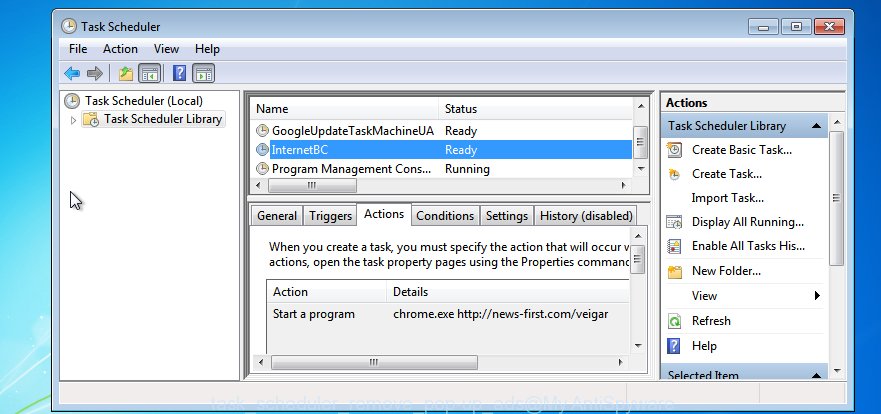
Task scheduler
In the middle part you will see a list of installed tasks. Please select the first task, its properties will be display just below automatically. Next, press the Actions tab. Pay attention to that it launches on your PC. If you are not sure that executes the task, check it through a search engine. If it is a component of the ‘ad-supported’ program, then this task also should be removed.
Having defined the task that you want to delete, then press on it with the right mouse button and choose Delete as shown on the image below.

Delete a task
Repeat this step, if you have found a few tasks that have been created by the CloudFront redirect virus. Once is finished, close the Task Scheduler window.
Fix hijacked web-browsers shortcuts to remove CloudFront redirect
Once installed, this ‘ad supported’ software that responsible for the appearance of CloudFront pop up advertisements, may add an argument such as “http://site.address” into the Target property of the desktop shortcut for the Internet Explorer, Google Chrome, Firefox and MS Edge. Due to this, every time you run the browser, it’ll display an undesired ad web-page.
Right click to a desktop shortcut file for your hijacked web-browser. Choose the “Properties” option. It’ll open the Properties window. Select the “Shortcut” tab here, after that, look at the “Target” field. The adware that responsible for internet browser redirect to annoying CloudFront pages can change it. If you are seeing something such as “…exe http://site.address” then you need to remove “http…” and leave only, depending on the web-browser you are using:
- Google Chrome: chrome.exe
- Opera: opera.exe
- Firefox: firefox.exe
- Internet Explorer: iexplore.exe
Look at the example as displayed in the figure below.

Once is finished, click the “OK” button to save the changes. Please repeat this step for internet browser shortcut files which redirects to unwanted web sites. When you have finished, go to next step.
Delete CloudFront redirect from Mozilla Firefox by resetting web browser settings
The FF reset will keep your personal information such as bookmarks, passwords, web form auto-fill data, restore preferences and security settings, get rid of redirects to unwanted CloudFront web pages.
Start the Mozilla Firefox and press the menu button (it looks like three stacked lines) at the top right of the web browser screen. Next, click the question-mark icon at the bottom of the drop-down menu. It will open the slide-out menu.
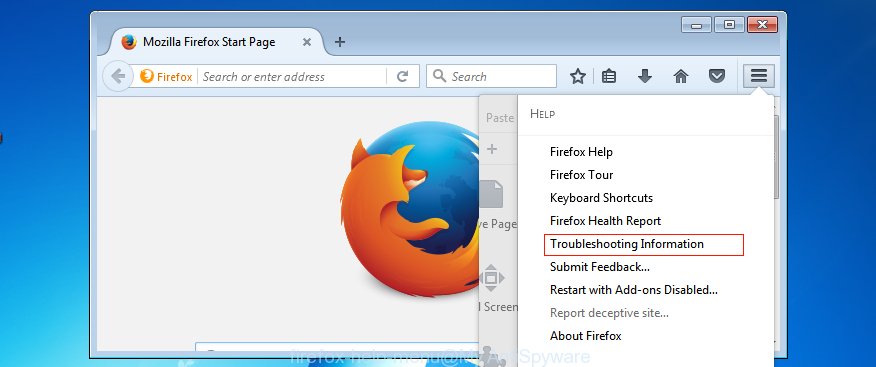
Select the “Troubleshooting information”. If you are unable to access the Help menu, then type “about:support” in your address bar and press Enter. It bring up the “Troubleshooting Information” page as shown in the following example.
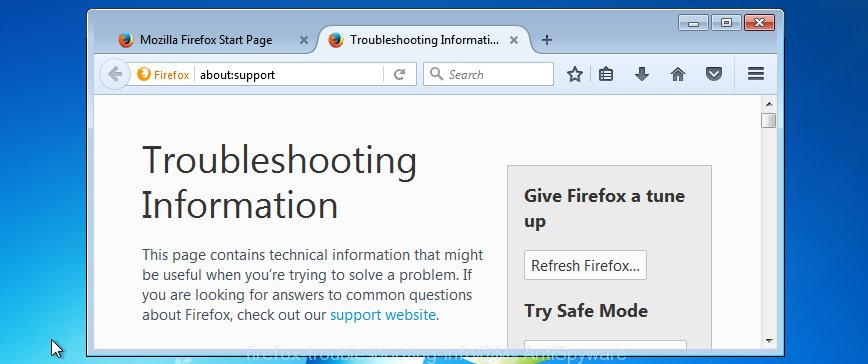
Click the “Refresh Firefox” button at the top right of the Troubleshooting Information page. Select “Refresh Firefox” in the confirmation dialog box. The Firefox will start a task to fix your problems that caused by the adware that causes tons of unwanted CloudFront pop-ups. After, it is finished, click the “Finish” button.
Remove CloudFront pop up advertisements from IE
By resetting IE browser you return your web-browser settings to its default state. This is basic when troubleshooting problems that might have been caused by adware which developed to reroute your web browser to unwanted CloudFront pages.
First, run the Internet Explorer, click ![]() ) button. Next, press “Internet Options” as shown on the image below.
) button. Next, press “Internet Options” as shown on the image below.

In the “Internet Options” screen select the Advanced tab. Next, click Reset button. The Internet Explorer will open the Reset Internet Explorer settings prompt. Select the “Delete personal settings” check box and click Reset button.

You will now need to restart your system for the changes to take effect. It will get rid of ad-supported software that causes web-browsers to display annoying CloudFront pop-up advertisements, disable malicious and ad-supported browser’s extensions and restore the IE’s settings like home page, default search provider and newtab page to default state.
Remove CloudFront redirect from Chrome
Like other modern internet browsers, the Chrome has the ability to reset the settings to their default values and thereby restore the web-browser’s settings like newtab, search provider and home page that have been changed by the ad supported software that causes multiple unwanted pop up advertisements.

- First start the Chrome and press Menu button (small button in the form of three dots).
- It will display the Google Chrome main menu. Select More Tools, then click Extensions.
- You’ll see the list of installed addons. If the list has the addon labeled with “Installed by enterprise policy” or “Installed by your administrator”, then complete the following guide: Remove Chrome extensions installed by enterprise policy.
- Now open the Chrome menu once again, click the “Settings” menu.
- You will see the Google Chrome’s settings page. Scroll down and click “Advanced” link.
- Scroll down again and click the “Reset” button.
- The Chrome will display the reset profile settings page as shown on the screen above.
- Next press the “Reset” button.
- Once this procedure is finished, your internet browser’s homepage, new tab and search engine will be restored to their original defaults.
- To learn more, read the article How to reset Google Chrome settings to default.
How to automatically delete CloudFront redirect virus
If your PC system is still infected with adware that causes annoying CloudFront pop up ads, then the best way of detection and removal is to use an anti-malware scan on the system. Download free malicious software removal utilities below and launch a full system scan. It will allow you get rid of all components of the adware from hardisk and Windows registry.
Automatically remove CloudFront popup ads with Zemana Anti-malware
Zemana Anti-malware is a tool that can get rid of ‘ad supported’ software, PUPs, browser hijackers and other malware from your computer easily and for free. Zemana Anti-malware is compatible with most antivirus software. It works under Windows (10 – XP, 32 and 64 bit) and uses minimum of personal computer resources.
Visit the page linked below to download Zemana Anti Malware (ZAM). Save it on your MS Windows desktop or in any other place.
164771 downloads
Author: Zemana Ltd
Category: Security tools
Update: July 16, 2019
After downloading is done, close all windows on your computer. Further, launch the set up file named Zemana.AntiMalware.Setup. If the “User Account Control” dialog box pops up as shown in the following example, click the “Yes” button.

It will display the “Setup wizard” which will allow you install Zemana on the computer. Follow the prompts and do not make any changes to default settings.

Once install is finished successfully, Zemana will automatically start and you may see its main window like below.

Next, click the “Scan” button to perform a system scan with this tool for the adware that causes web browsers to display annoying CloudFront pop-up ads. Depending on your computer, the scan can take anywhere from a few minutes to close to an hour. While the utility is checking, you may see how many objects and files has already scanned.

After finished, Zemana Free will show a scan report. Make sure all threats have ‘checkmark’ and click “Next” button.

The Zemana will delete adware responsible for CloudFront pop up ads and add items to the Quarantine. Once the clean-up is finished, you can be prompted to restart your PC.
Remove CloudFront popup advertisements and harmful extensions with Hitman Pro
Hitman Pro is a portable program that requires no hard setup to find and remove adware related to CloudFront pop-up ads. The application itself is small in size (only a few Mb). HitmanPro does not need any drivers and special dlls. It is probably easier to use than any alternative malicious software removal utilities you’ve ever tried. Hitman Pro works on 64 and 32-bit versions of Windows 10, 8, 7 and XP. It proves that removal tool can be just as useful as the widely known antivirus programs.
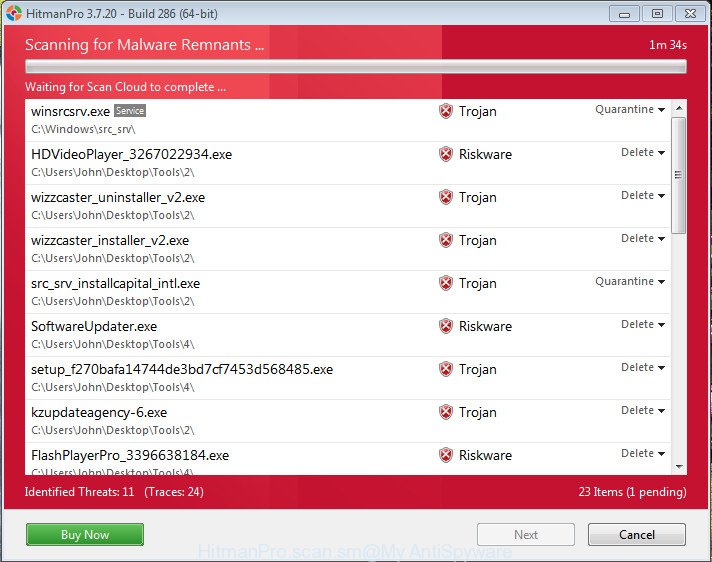
- Visit the page linked below to download Hitman Pro. Save it to your Desktop.
- Once the download is finished, run the HitmanPro, double-click the HitmanPro.exe file.
- If the “User Account Control” prompts, click Yes to continue.
- In the Hitman Pro window, click the “Next” to perform a system scan with this utility for the adware that cause intrusive CloudFront advertisements to appear. A scan can take anywhere from 10 to 30 minutes, depending on the number of files on your computer and the speed of your personal computer. During the scan Hitman Pro will search for threats exist on your PC.
- Once that process is complete, you may check all items found on your system. Next, you need to click “Next”. Now, click the “Activate free license” button to begin the free 30 days trial to delete all malware found.
Run Malwarebytes to remove CloudFront pop up advertisements
We recommend using the Malwarebytes Free which are completely clean your system of the ad supported software. The free utility is an advanced malicious software removal program made by (c) Malwarebytes lab. This program uses the world’s most popular antimalware technology. It is able to help you delete undesired CloudFront pop-up ads from your web-browsers, PUPs, malware, hijackers, toolbars, ransomware and other security threats from your PC for free.
Visit the page linked below to download MalwareBytes Free. Save it on your MS Windows desktop or in any other place.
327032 downloads
Author: Malwarebytes
Category: Security tools
Update: April 15, 2020
When the download is finished, close all apps and windows on your computer. Open a directory in which you saved it. Double-click on the icon that’s named mb3-setup as shown below.
![]()
When the installation begins, you’ll see the “Setup wizard” that will help you setup Malwarebytes on your computer.
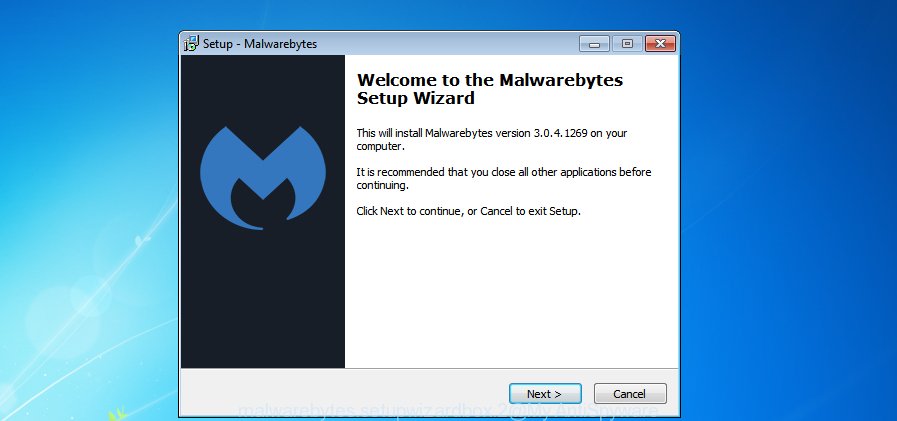
Once installation is finished, you will see window as displayed below.
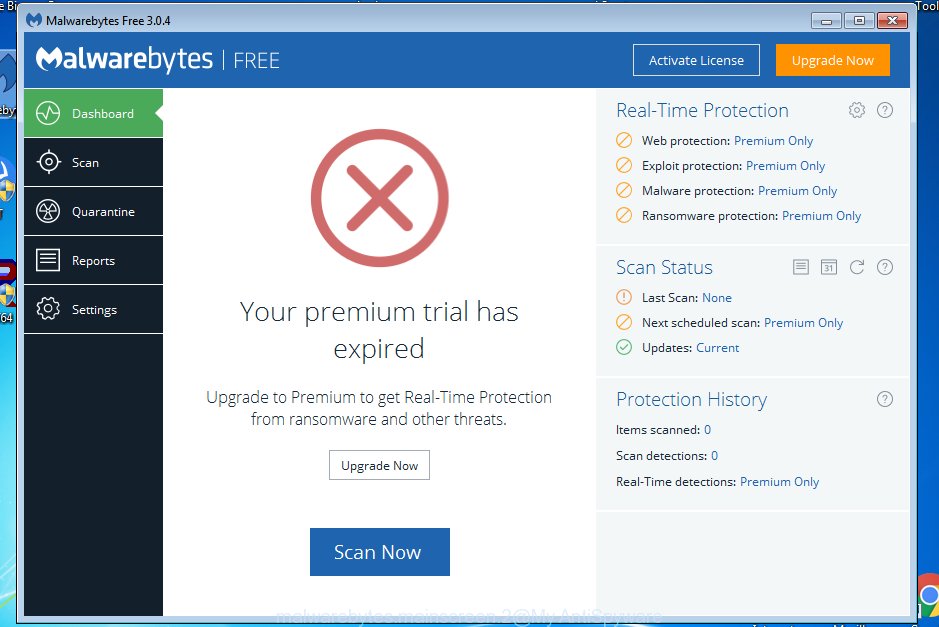
Now click the “Scan Now” button to find adware that causes tons of annoying CloudFront pop-up advertisements. This process can take quite a while, so please be patient. When a malware, adware or potentially unwanted applications are detected, the number of the security threats will change accordingly.
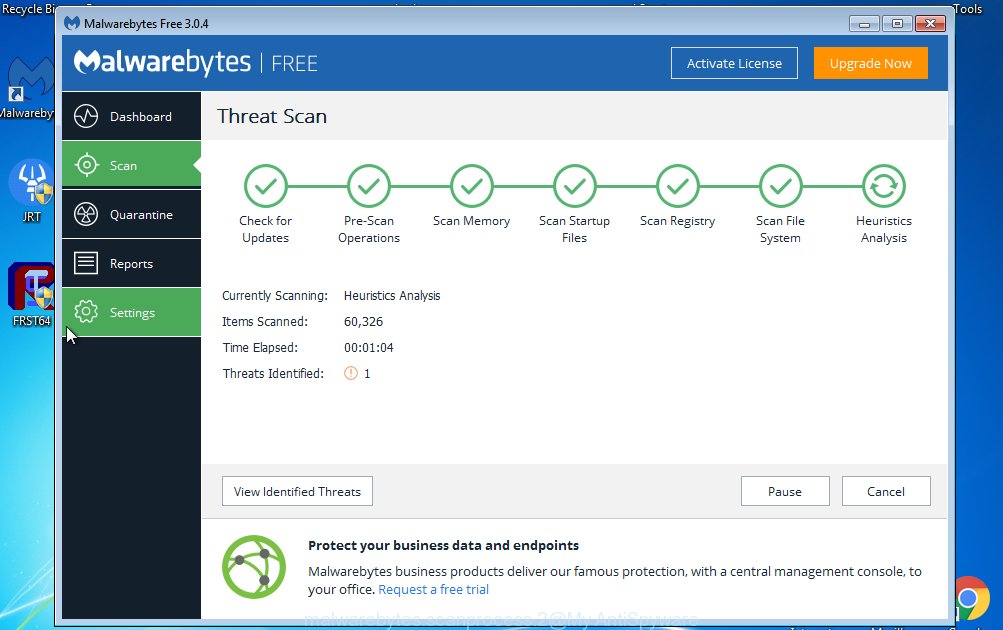
After the scan is complete, MalwareBytes AntiMalware (MBAM) will open a list of detected threats. Once you have selected what you want to remove from your computer press “Quarantine Selected” button.
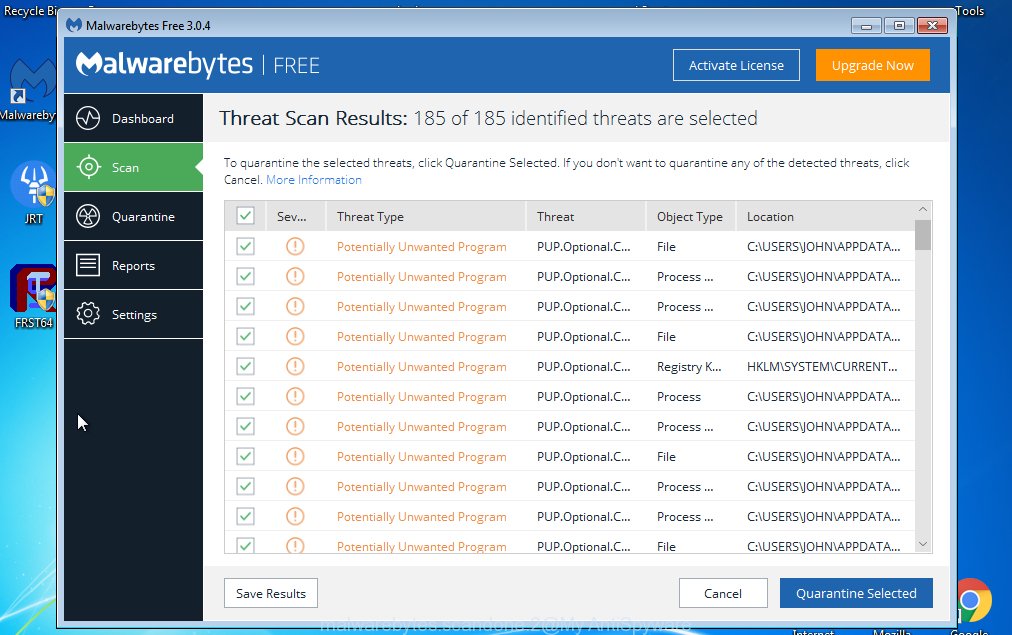
The Malwarebytes will now begin to get rid of adware which cause intrusive CloudFront pop-up ads to appear. After the clean-up is finished, you may be prompted to reboot your PC system.

The following video explains instructions on how to remove browser hijacker infection, ad-supported software and other malicious software with MalwareBytes Free.
Block CloudFront redirect and other annoying web-pages
By installing an ad blocking application such as AdGuard, you’re able to stop CloudFront redirect, autoplaying video ads and delete a ton of distracting and undesired ads on web-pages.
Visit the following page to download AdGuard. Save it to your Desktop so that you can access the file easily.
26838 downloads
Version: 6.4
Author: © Adguard
Category: Security tools
Update: November 15, 2018
Once the downloading process is done, double-click the downloaded file to launch it. The “Setup Wizard” window will show up on the computer screen like below.

Follow the prompts. AdGuard will then be installed and an icon will be placed on your desktop. A window will show up asking you to confirm that you want to see a quick instructions like below.

Press “Skip” button to close the window and use the default settings, or click “Get Started” to see an quick guidance that will assist you get to know AdGuard better.
Each time, when you run your machine, AdGuard will run automatically and block pop-ups, CloudFront redirect, as well as other harmful or misleading web-sites. For an overview of all the features of the application, or to change its settings you can simply double-click on the AdGuard icon, that can be found on your desktop.
How can you prevent your computer from the attack of CloudFront redirect virus
Many of the free applications out there install unwanted browser toolbars, browser hijacker infections and potentially unwanted applications along with them without your knowledge. One has to be attentive while installing freeware in order to avoid accidentally installing additional applications. It’s important that you pay attention to the EULA (End User License Agreements) and select the Custom, Manual or Advanced installation option as it will typically disclose what bundled applications will also be installed.
Finish words
Once you’ve complete the few simple steps shown above, your computer should be clean from any adware and other malware. The FF, Microsoft Edge, Google Chrome and Internet Explorer will no longer display annoying CloudFront web-pages when you browse the Internet. Unfortunately, if the step by step instructions does not help you, then you have caught a new adware, and then the best way – ask for help.
Please start a new thread by using the “New Topic” button in the Spyware Removal forum. When posting your HJT log, try to give us some details about your problems, so we can try to help you more accurately. Wait for one of our trained “Security Team” or Site Administrator to provide you with knowledgeable assistance tailored to your problem with the unwanted CloudFront redirect.



















